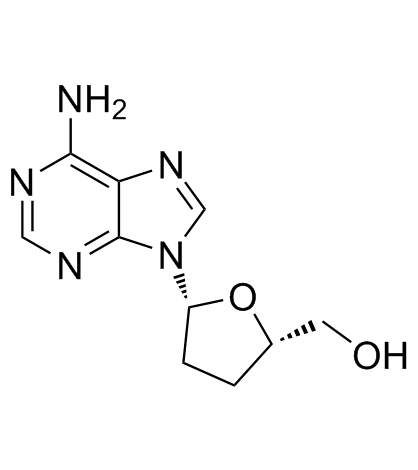2',3'-Dideoxyadenosine

2',3'-Dideoxyadenosine structure
|
Common Name | 2',3'-Dideoxyadenosine | ||
|---|---|---|---|---|
| CAS Number | 4097-22-7 | Molecular Weight | 235.242 | |
| Density | 1.8±0.1 g/cm3 | Boiling Point | 539.1±60.0 °C at 760 mmHg | |
| Molecular Formula | C10H13N5O2 | Melting Point | 181-184 °C(lit.) | |
| MSDS | Chinese USA | Flash Point | 279.9±32.9 °C | |
|
RGS19 converts iron deprivation stress into a growth-inhibitory signal
Biochem. Biophys. Res. Commun. 464 , 168-75, (2015) Iron chelation is a promising therapeutic strategy for cancer that works, in part, by inducing overexpression of N-myc downstream-regulated gene 1 protein (NDRG1), a known growth inhibitor and metastasis suppressor. However, details of the signaling cascades ... |
|
|
The cyclic AMP pathway is a sex-specific modifier of glioma risk in type I neurofibromatosis patients.
Cancer Res. 75(1) , 16-21, (2015) Identifying modifiers of glioma risk in patients with type I neurofibromatosis (NF1) could help support personalized tumor surveillance, advance understanding of gliomagenesis, and potentially identify novel therapeutic targets. Here, we report genetic polymo... |
|
|
Metformin as adjunct antituberculosis therapy.
Sci. Transl. Med. 6(263) , 263ra159, (2014) The global burden of tuberculosis (TB) morbidity and mortality remains immense. A potential new approach to TB therapy is to augment protective host immune responses. We report that the antidiabetic drug metformin (MET) reduces the intracellular growth of Myc... |
|
|
Inhibition of Mycobacterium tuberculosis, Mycobacterium bovis, and Mycobacterium avium by novel dideoxy nucleosides.
J. Med. Chem. 50 , 4766-74, (2007) The prevalence of tuberculosis (TB) and mutidrug-resistant tuberculosis (MDR-TB) has been increasing, leading to serious infections, high mortality, and a global health threat. Here, we report the identification of a novel class of dideoxy nucleosides as pote... |
|
|
Neonatal regulatory T cells have reduced capacity to suppress dendritic cell function.
Eur. J. Immunol. 45 , 2582-92, (2015) Regulatory T cells (Treg cells) limit contact between dendritic cells (DCs) and conventional T cells (Tcons), decreasing the formation of aggregates as well as down-modulating the expression of co-stimulatory molecules by DCs, thus decreasing DC immunogenicit... |
|
|
A new site and mechanism of action for the widely used adenylate cyclase inhibitor SQ22,536.
Mol. Pharmacol. 83(1) , 95-105, (2013) We evaluated the efficacy, potency, and selectivity of the three most commonly used adenylate cyclase (AC) inhibitors in a battery of cell lines constructed to study signaling via three discrete cAMP sensors identified in neuroendocrine cells. SQ22,536 [9-(te... |
|
|
Identification of 17,20β,21-trihydroxy-4-pregnen-3-one (20β-S) receptor binding and membrane progestin receptor alpha on southern flounder sperm (Paralichthys lethostigma) and their likely role in 20β-S stimulation of sperm hypermotility.
Gen. Comp. Endocrinol. 170(3) , 629-39, (2011) The existence of direct progestin actions on teleost sperm to stimulate hypermotility is not widely acknowledged because it has only been demonstrated in members of the family Sciaenidae. In the present study, progestin stimulation of sperm hypermotility was ... |
|
|
Efficacy, safety, and immunogenicity of the human papillomavirus 16/18 AS04-adjuvanted vaccine in women older than 25 years: 4-year interim follow-up of the phase 3, double-blind, randomised controlled VIVIANE study.
Lancet 384(9961) , 2213-27, (2015) Although adolescent girls are the main population for prophylactic human papillomavirus (HPV) vaccines, adult women who remain at risk of cervical cancer can also be vaccinated. We report data from the interim analysis of the ongoing VIVIANE study, the aim of... |
|
|
Signaling from the human melanocortin 1 receptor to ERK1 and ERK2 mitogen-activated protein kinases involves transactivation of cKIT.
Mol. Endocrinol. 25 , 138-156, (2011) Melanocortin 1 receptor (MC1R), a Gs protein-coupled receptor expressed in melanocytes, is a major determinant of skin pigmentation, phototype and cancer risk. Upon stimulation by αMSH, MC1R triggers the cAMP and ERK1/ERK2 MAPK pathways. In mouse melanocytes,... |
|
|
The base component of 3'-azido-2',3'-dideoxynucleosides influences resistance mutations selected in HIV-1 reverse transcriptase.
Antimicrob. Agents Chemother. 55(8) , 3758-64, (2011) We recently reported that HIV-1 resistant to 3'-azido-3'-deoxythymidine (AZT) is not cross-resistant to 3'-azido-2',3'-dideoxypurines. This finding suggested that the nucleoside base is a major determinant of HIV-1 resistance to nucleoside analogs. To further... |